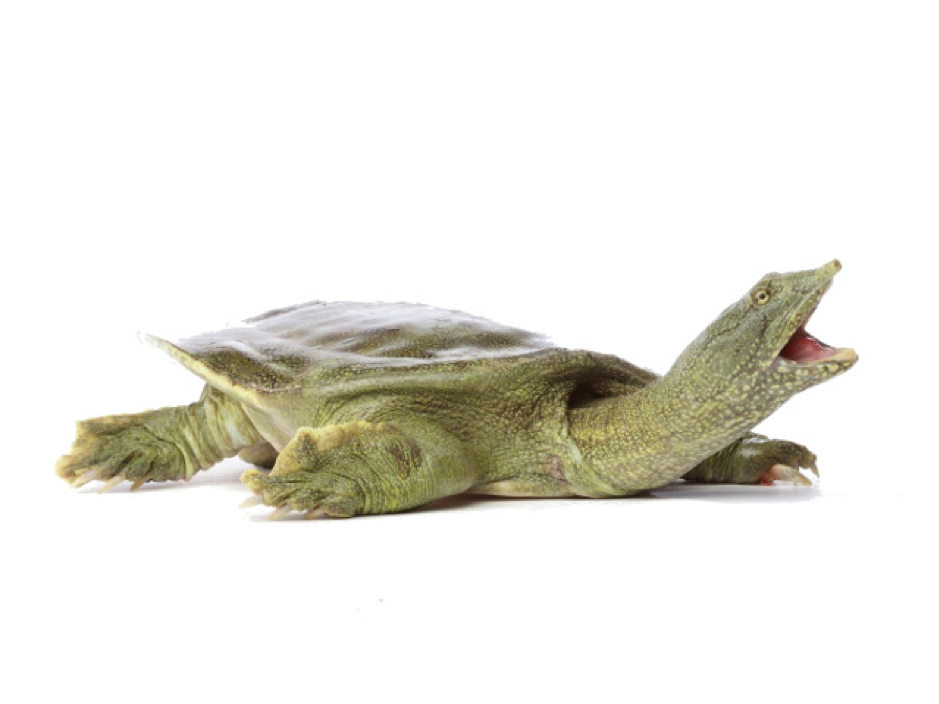
Chinese Softshell Turtle Caresheet
Introduction
Chinese softshell turtles are without doubt a strange looking turtle with their flat and pancake like shell, their lack of bony scutes, and their snorkel-like neck which enables them stay hidden under the sand whilst able to stick their neck up like a snorkel for air. Their long neck also enables them to quickly ambush prey such as fish. Chinese softshell can live up to 30 years old and grow around 10-14 inches in length. Although they are indigenous to China, Chinese softshell turtles have established populations in East Asian countries such as Thailand and Malaysia. Chinese Softshell turtles can be quiet an aggressive species and will frequently bite. Furthermore, they will attack other turtles especially other Chinese softshell turtles.
Studies have found that Chinese softshell can breathe underwater by passing water over “fingers” (similar to fish gills) located in the turtles throat. These “fingers” extract oxygen from the water. One study found that the turtles were able to remain under water for more than 2 hours carrying out this neck/mouth rinsing action.

Chinese Softshell Turtle Photo
Habitat and Housing
Chinese softshell turtles will generally attack one another if kept together in aquariums, so they should be housed individually in this instance. Hatchling Chinese softshells can be kept in a 2/3 foot long aquarium. Adults however will require a much larger aquarium or ideally a pond. The water depth should be at least twice the width of the turtle’s shell. The water temperature should range between 24-29 degrees Celsius. This can be achieved using an aquarium heater. An underwater hiding place should be provided where the turtle can hide but cannot become trapped and drown. As their name suggests softshell turtles have very soft and penetrable shells so a sand bottom to your enclosure is a must where the turtle can borrow without cutting itself. Avoid any sharp objects in the aquarium which may damage the turtle and cause infections.
A basking area is crucial, where the turtle can leave the water and fully dry off. The basking area’s temperature should be between 30-35 degrees Celsius. This can be provided by fitting a heat lamp to your aquarium. Chinese softshells require UVB lighting to survive. UVB provides the turtle with vitamin D3 which then enables the turtle to absorb Calcium from its food. Without Vitamin D3 the turtle will develop metabolic bone disease (MBD) and eventually die. This can be provided by using bulbs which emit UVB which are readily available from any pet shop.
Water quality is very important as turtles can develop health issues due to inadequate water quality. One way to help ensure good water quality is by using an aquarium or pond filter. External filters are generally more suitable than internal filters as they are larger, and the turtle cannot dislodge the filter causing it to malfunction. Frequent water changes are also necessary to ensure good water quality. Artificial plants, rounded stones and logs should be added to the enclosure to create a more natural look and feel.
Feeding and Diet
Chinese softshell turtles are primarily a carnivore. Good foods include; fish, worms, insects, frogs and snails. There are a wide variety of commercial turtle foods available. There are a number of vitamins and minerals which are crucial to ensure your turtles healthy development and wellbeing, so it is important to choose a turtle food with a wide range of Vitamins and minerals or add them using a multivitamin and calcium supplement.
It is important not to overfeed your turtle as it will have health implications. Overfeeding in turtles has been shown to cause liver problems, shell deformation and shortened lifespan. Hatchlings should be fed every 2nd day while adults should be fed approximately two times every week.
Chinese Softshell Turtle Health
- Poor water quality can result in your turtle developing skin, shell, and ear infections. Ear infections commonly show up as large bumps behind your turtle's eyes and need to be addressed by your vet.
- Swollen eyes can occur due to a lack of vitamin A in the turtle’s diet. The eyes appear pink and swollen. There are eye drops available but in severe cases a vet should be consulted. The best way to prevent this problem is to provide your turtle with the appropriate diet.
- Metabolic bone disease (MBD) will occur if your turtle isn’t receiving sufficient levels of vitamin D3 and calcium. This will lead to shell deformation, limpness, decreased appetite and if left untreated eventually death. A vet should be consulted if you think your turtle is suffering from MBD.
- Shell Rot can occur if your turtle doesn’t have access to an adequate basking area where it can fully dry off. It causes the shell to literally rot away over time. If left untreated shell rot will gradually get worse. If you think your turtle has shell rot contact your veterinarian.
Sexing and Breeding
Male and Females can be distinguished by observing the position of the cloaca on the turtle’s tail. The Males softshell turtle’s cloaca will be located at the end of their tail, whereas the female’s cloaca is located near the start of the tail which is closer to the shell. Male softshell turtles will usually have longer tails than the females also.
Breeding will take place in the spring. Turtles will begin to lay their eggs in March in warmer climates. Softshell turtles can nest a number of times every year, usually laying between 8 to 24 eggs at a time. The eggs will hatch after approximately 60-80 days.
References and Further reading
Kirkpatrick, D. T. (2006) Aquatic Turtles. 1st Edition: T.F.H Publications.
Morgan, M. Softshell Turtles Information and care. Available at: http://www.reptilesmagazine.com/Turtles-Tortoises/Turtle-Care/Soft-Shelled-Turtle-Information-and-Care/ [Accessed 24/07/2019].
